Charles Darwin was the first person to propose
A) that
evolution occurs.
B) a mechanism for how evolution occurs.
C) that Earth is older than a few thousand years.
D) a
mechanism for evolution that was supported by evidence.
E) that
population growth can outpace the growth of food resources.
D
Natural selection is based on all of the following except
A)
genetic variation exists within populations.
B) the best-adapted
individuals tend to leave the most offspring.
C) individuals who
survive longer tend to leave more offspring than those who die young.
D) populations tend to produce more individuals than the
environment can support.
E) individuals adapt to their
environments and, thereby, evolve.
E
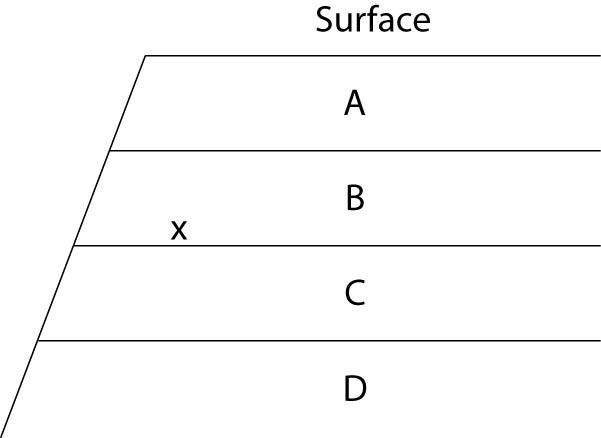
The following questions refer to Figure 22.1, which shows an outcrop
of sedimentary rock whose strata are labeled AD.
38) If x indicates the location of fossils of two closely
related species, then fossils of their most-recent common ancestor are
most likely to occur in which stratum?
A) A
B) B
C)
C
D) D
C
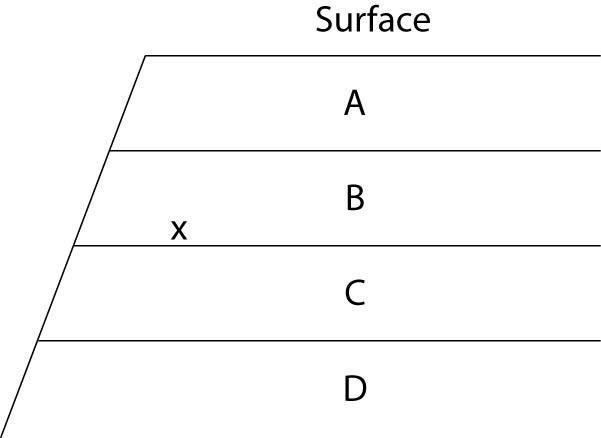
The following questions refer to Figure 22.1, which shows an outcrop
of sedimentary rock whose strata are labeled AD.
39) If x indicates the fossils of two closely related species,
neither of which is extinct, then their remains may be found in how
many of these strata?
A) one stratum
B) two strata
C) three strata
D) four strata
B
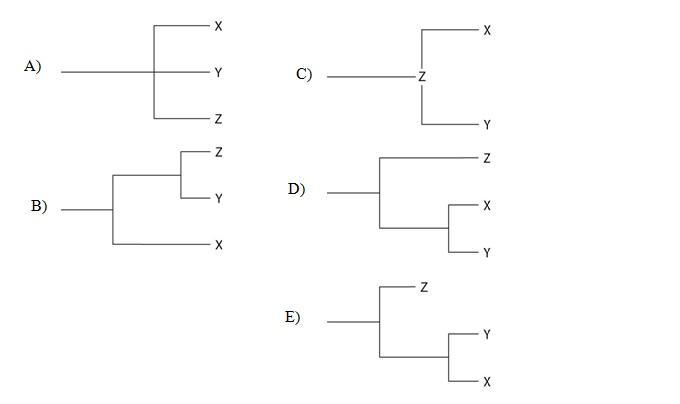
40) Currently, two extant elephant species (X and Y) are placed in the genus Loxodonta and a third species (Z) is placed in the genus Elephas. Assuming this classification reflects evolutionary relatedness, which of the following is the most accurate phylogenetic tree?
D
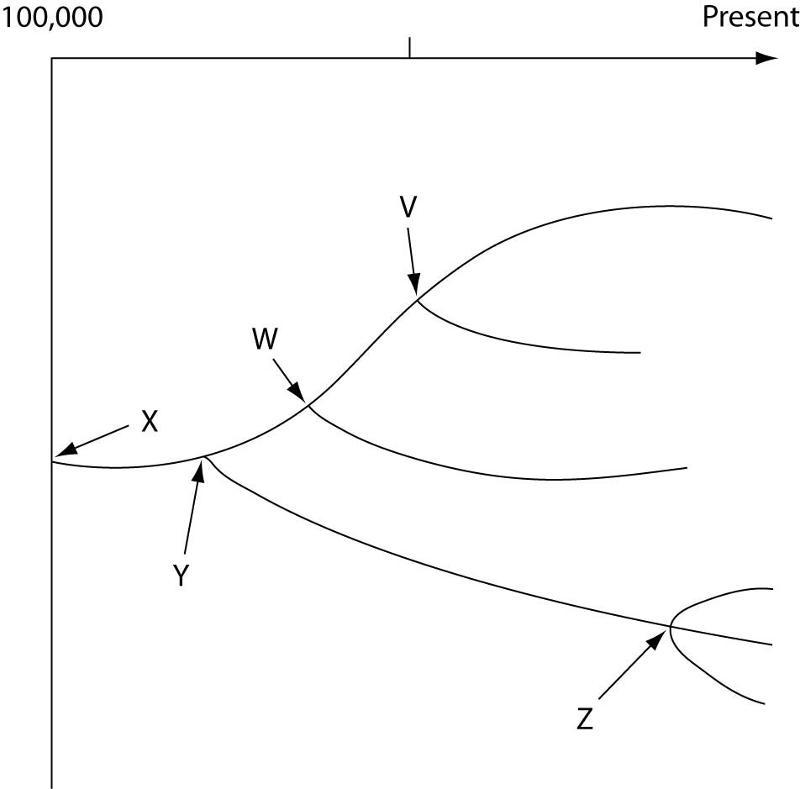
41) How many separate species, both extant and extinct, are depicted
in this tree?
A) two
B) three
C) four
D) five
E) six
E
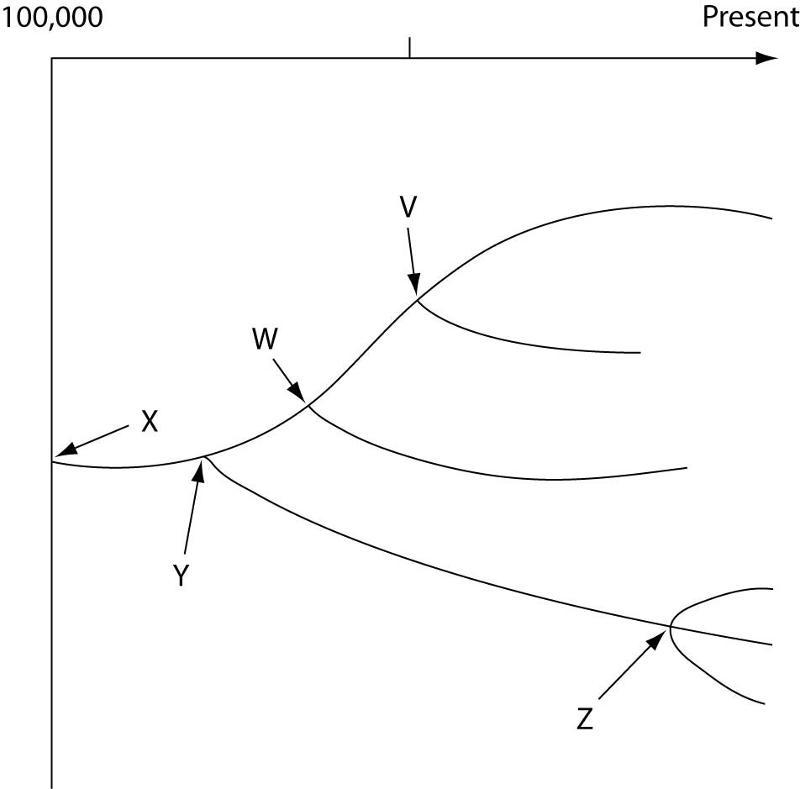
43) Which of the five common ancestors, labeled V-Z, has given rise
to the greatest number of species, both extant and extinct?
A) V
B) W
C) Z
D) Both W and Z can be considered to have
given rise to the greatest number of extant and extinct species.
E) Both X and Y can be considered to have given rise to the
greatest number of extant and extinct species.
E
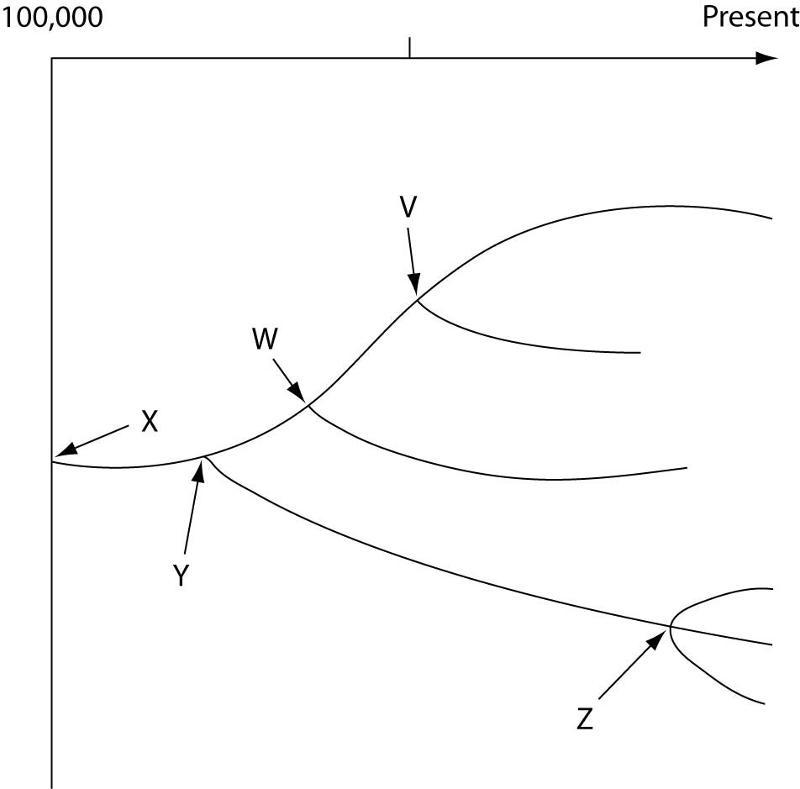
46) Which pair would probably have agreed with the process that is
depicted by this tree?
A) Cuvier and Lamarck
B) Lamarck
and Wallace
C) Aristotle and Lyell
D) Wallace and Linnaeus
E) Linnaeus and Lamarck
B
The legless condition that is observed in several groups of extant
reptiles is the result of
A) their common ancestor having been
legless.
B) a shared adaptation to an arboreal (living in trees)
lifestyle.
C) several instances of the legless condition arising
independently of each other.
D) individual lizards adapting to a
fossorial (living in burrows) lifestyle during their lifetimes.
C
9) The best classification system is that which most closely
A)
unites organisms that possess similar morphologies.
B) conforms
to traditional, Linnaean taxonomic practices.
C) reflects
evolutionary history.
D) reflects the basic separation of
prokaryotes from eukaryotes.
C
7) The term homoplasy is most applicable to which of the following
features?
A) the legless condition found in various lineages of
extant lizards
B) the five-digit condition of human hands and
bat wings
C) the β hemoglobin genes of mice and of humans
D) the fur that covers Australian moles and North American moles
E) the bones of bat forelimbs and the bones of bird forelimbs
A
if, someday, an archaean cell is discovered whose rRNA sequence is
more similar to that of humans than the sequence of mouse rRNA is to
that of humans, the best explanation for this apparent discrepancy
would be
A) homology.
B) homoplasy.
C) common
ancestry.
D) retro-evolution by humans.
E) coevolution of
humans and that archaean.
B
16) When using a cladistic approach to systematics, which of the
following is considered most important for classification?
A)
shared primitive characters
B) analogous primitive characters
C) shared derived characters
D) the number of homoplasies
E) overall phenotypic similarity
C
Cladograms (a type of phylogenetic tree) constructed from evidence
from molecular systematics are based on similarities in
A)
morphology.
B) the pattern of embryological development.
C) biochemical pathways.
D) habitat and lifestyle choices.
E) mutations to homologous genes.
E
There is some evidence that reptiles called cynodonts may have had
whisker-like hairs around their mouths. If true, then what can be
properly said of hair?
A) It is a shared derived character of
mammals, even if cynodonts continue to be classified as reptiles.
B) It is a shared derived character of the amniote clade, and
not of the mammal clade.
C) It is a shared ancestral character
of the amniote clade, but only if cynodonts are reclassified as
mammals.
D) It is a shared derived character of the mammals, but
only if cynodonts are reclassified as mammals.
D
A phylogenetic tree constructed using sequence differences in
mitochondrial DNA would be most valid for discerning the evolutionary
relatedness of
A) archaeans and bacteria.
B) fungi and
animals.
C) chimpanzees and humans.
D) sharks and
dolphins.
E) mosses and ferns.
C
The most important feature that permits a gene to act as a molecular
clock is
A) having a large number of base pairs.
B) having
a larger proportion of exonic DNA than of intronic DNA.
C)
having a reliable average rate of mutation.
D) its recent origin
by a gene-duplication event.
E) its being acted upon by natural selection.
C
30) Neutral theory proposes that
A) molecular clocks are more
reliable when the surrounding pH is close to 7.0.
B) most
mutations of highly conserved DNA sequences should have no functional
effect.
C) DNA is less susceptible to mutation when it codes for
amino acid sequences whose side groups (or R groups) have a neutral
pH.
D) DNA is less susceptible to mutation when it codes for
amino acid sequences whose side groups (or R groups) have a neutral
electrical charge.
E) a significant proportion of mutations are
not acted upon by natural selection.
E
23) Which kind of DNA should provide the best molecular clock for
determining the evolutionary relatedness of several species whose
common ancestor became extinct billions of years ago?
A) that
coding for ribosomal RNA
B) intronic DNA belonging to a gene
whose product performs a crucial function
C) paralogous DNA that
has lost its function (i.e., no longer codes for functional gene
product)
D) mitochondrial DNA
E) exonic DNA that codes for
a noncrucial part of a polypeptide
A
What kind of evidence has recently made it necessary to assign the
prokaryotes to either of two different domains, rather than assigning
all prokaryotes to the same kingdom?
A) molecular
B)
behavioral
C) nutritional
D) anatomical
E) ecological
A
Which kingdom has been replaced with two domains?
A) Plantae
B) Fungi
C) Animalia
D) Protista
E) Monera
E
Which eukaryotic kingdom is polyphyletic, and therefore unacceptable,
based on cladistics?
A) Plantae
B) Fungi
C) Animalia
D) Protista
E) Monera
D
Which of these variables is likely to undergo the largest change in
value as the result of a mutation that introduces a brand-new allele
into a population's gene pool at a locus that had formerly been fixed?
A) average heterozygosity
B) nucleotide variability
C) geographic variability
D) average number of loci
A
he higher the proportion of loci that are "fixed" in a
population, the lower is that population's
A) nucleotide
variability only.
B) genetic polyploidy only.
C) average
heterozygosity only.
D) nucleotide variability, average
heterozygosity, and genetic polyploidy.
E) nucleotide
variability and average heterozygosity only.
E
Rank the following one-base point mutations (from most likely to
least likely) with respect to their likelihood of affecting the
structure of the corresponding polypeptide:
1. insertion
mutation deep within an intron
2. substitution mutation at the
third position of an exonic codon
3. substitution mutation at
the second position of an exonic codon
4. deletion mutation
within the first exon of the gene
A) 1, 2, 3, 4
B) 4, 3, 2, 1
C) 2, 1, 4, 3
D)
3, 1, 4, 2
E) 2, 3, 1, 4
B
Which of the following is a true statement concerning genetic
variation?
A) It is created by the direct action of natural
selection.
B) It arises in response to changes in the
environment.
C) It must be present in a population before
natural selection can act upon the population.
D) It tends to be
reduced by the processes involved when diploid organisms produce
gametes.
E) A population that has a higher average
heterozygosity has less genetic variation than one with a lower
average heterozygosity.
C
Whenever diploid populations are in Hardy-Weinberg equilibrium at a
particular locus
A) the allele's frequency should not change
from one generation to the next, but its representation in homozygous
and heterozygous genotypes may change.
B) natural selection,
gene flow, and genetic drift are acting equally to change an allele's
frequency.
C) this means that, at this locus, two alleles are
present in equal proportions.
D) the population itself is not
evolving, but individuals within the population may be evolving.
A
In the formula for determining a population's genotype frequencies,
the 2 in the term 2pq is necessary because
A) the population is
diploid.
B) heterozygotes can come about in two ways.
C)
the population is doubling in number.
D) heterozygotes have two alleles.
B
In a Hardy-Weinberg population with two alleles, A and a, that are in
equilibrium, the frequency of the allele a is 0.3. What is the
percentage of the population that is homozygous for this allele?
A) 0.09
B) 0.49
C) 0.9
D) 9.0
E) 49.0
D
In a Hardy-Weinberg population with two alleles, A and a, that are in
equilibrium, the frequency of allele a is 0.1. What is the frequency
of individuals with AA genotype?
A) 0.20
B) 0.32
C)
0.42
D) 0.81
E) Genotype frequency cannot be determined
from the information provided.
D
Which of the following is most likely to produce an African butterfly
species in the wild whose members have one of two strikingly different
color patterns?
A) artificial selection
B) directional
selection
C) stabilizing selection
D) disruptive selection
E) sexual selection
D
The recessive allele that causes phenylketonuria (PKU) is harmful,
except when an infant's diet lacks the amino acid phenylalanine. What
maintains the presence of this harmful allele in a population's gene
pool?
A) heterozygote advantage
B) stabilizing selection
C) diploidy
D) balancing selection
C
Heterozygote advantage should be most closely linked to which of the
following?
A) sexual selection
B) stabilizing selection
C) random selection
D) directional selection
E)
disruptive selection
B
In seedcracker finches from Cameroon, small- and large-billed birds
specialize in cracking soft and hard seeds, respectively. If long-term
climatic change resulted in all seeds becoming hard, what type of
selection would then operate on the finch population?
A)
disruptive selection
B) directional selection
C)
stabilizing selection
D) No selection would operate because the
population is in Hardy-Weinberg equilibrium.
B
When imbalances occur in the sex ratio of sexual species that have
two sexes (i.e., other than a 50:50 ratio), the members of the
minority sex often receive a greater proportion of care and resources
from parents than do the offspring of the majority sex. This is most
clearly an example of
A) sexual selection.
B) disruptive
selection.
C) balancing selection.
D) stabilizing
selection.
E) frequency-dependent selection.
E
A proficient engineer can easily design skeletal structures that are
more functional than those currently found in the forelimbs of such
diverse mammals as horses, whales, and bats. The actual forelimbs of
these mammals do not seem to be optimally arranged because
A)
natural selection has not had sufficient time to create the optimal
design in each case, but will do so given enough time.
B) in
many cases, phenotype is not merely determined by genotype, but by the
environment as well.
C) though we may not consider the fit
between the current skeletal arrangements and their functions
excellent, we should not doubt that natural selection ultimately
produces the best design.
D) natural selection is generally
limited to modifying structures that were present in previous
generations and in previous species.
D
There are those who claim that the theory of evolution cannot be true
because the apes, which are supposed to be closely related to humans,
do not likewise share the same large brains, capacity for complicated
speech, and tool-making capability. They reason that if these features
are generally beneficial, then the apes should have evolved them as
well. Which of these provides the best argument against this
misconception?
A) Advantageous alleles do not arise on demand.
B) A population's evolution is limited by historical
constraints.
C) Adaptations are often compromises.
D)
Evolution can be influenced by environmental change.
A
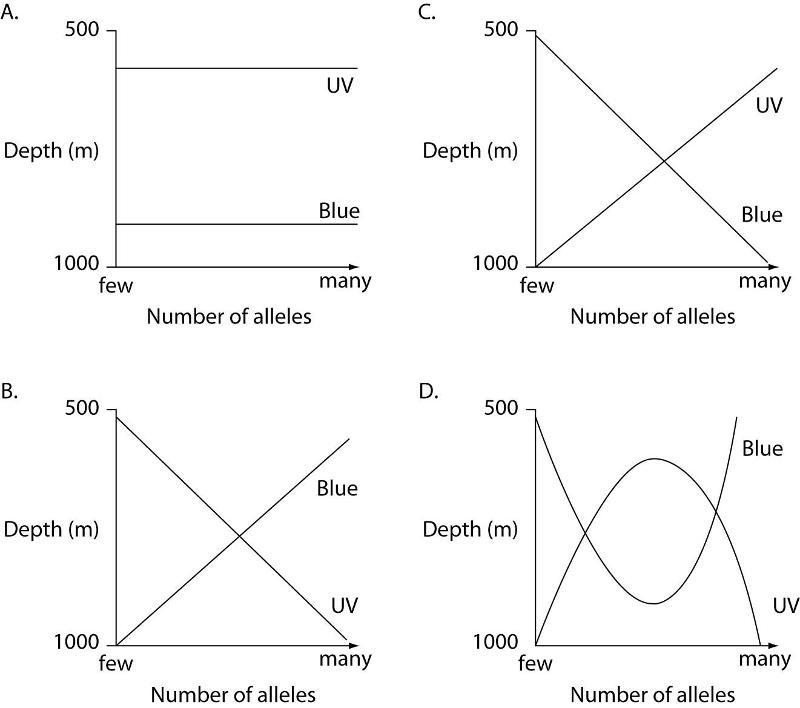
Blue light is that portion of the visible spectrum that penetrates
the deepest into bodies of water. Ultraviolet (UV) light, though, can
penetrate even deeper. A gene within a population of marine fish that
inhabits depths from 500 m to 1,000 m has an allele for a photopigment
that is sensitive to UV light, and another allele for a photopigment
that is sensitive to blue light. Which of the following graphs best
depicts the predicted distribution of these alleles within a
population if the fish that carry these alleles prefer to locate
themselves where they can see best? (SEE IMAGE)
A) A
B) B
C) C
D) D
B
HIV's genome of RNA includes the code for reverse transcriptase (RT),
an enzyme that acts early in infection to synthesize a DNA genome off
of an RNA template. The HIV genome also codes for protease (PR), an
enzyme that acts later in infection by cutting long viral polyproteins
into smaller, functional proteins. Both RT and PR represent potential
targets for antiretroviral drugs. Drugs called nucleoside analogs (NA)
act against RT, whereas drugs called protease inhibitors (PI) act
against PR.
51) Which of the following represents the treatment option most
likely to avoid the production of drug-resistant HIV (assuming no drug
interactions or side effects)?
A) using a series of NAs, one at
a time, and changed about once a week
B) using a single PI, but
slowly increasing the dosage over the course of a week
C) using
high doses of NA and a PI at the same time for a period not to exceed
one day
D) using moderate doses of NA and two different PIs at
the same time for several months
D
HIV's genome of RNA includes the code for reverse transcriptase (RT),
an enzyme that acts early in infection to synthesize a DNA genome off
of an RNA template. The HIV genome also codes for protease (PR), an
enzyme that acts later in infection by cutting long viral polyproteins
into smaller, functional proteins. Both RT and PR represent potential
targets for antiretroviral drugs. Drugs called nucleoside analogs (NA)
act against RT, whereas drugs called protease inhibitors (PI) act
against PR.
54) Every HIV particle contains two RNA molecules. If two genes
from one RNA molecule become detached and then, as a unit, get
attached to one end of the other RNA molecule within a single HIV
particle, which of these is true?
A) There are now fewer genes
within the viral particle.
B) There are now more genes within
the viral particle.
C) A point substitution mutation has
occurred in the retroviral genome.
D) The retroviral equivalent
of crossing over has occurred, no doubt resulting in a heightened
positive effect.
E) One of the RNA molecules has experienced
gene duplication as the result of translocation.
E
You are studying three populations of birds. Population A has ten
birds, of which one is brown (a recessive trait) and nine are red.
Population B has 100 birds, of which ten are brown. Population C has
30 birds, and three of them are brown.
59) In which population would it be least likely that an
accident would significantly alter the frequency of the brown allele?
A) population A
B) population B
C) population C
D) They are all the same.
E) It is impossible to tell from
the information given.
B
You are studying three populations of birds. Population A has ten
birds, of which one is brown (a recessive trait) and nine are red.
Population B has 100 birds, of which ten are brown. Population C has
30 birds, and three of them are brown.
60) Which population is most likely to be subject to the
bottleneck effect?
A) population A
B) population B
C) population C
D) They are all equally likely.
E)
It is impossible to tell from the information given.
A
You are maintaining a small population of fruit flies in the
laboratory by transferring the flies to a new culture bottle after
each generation. After several generations, you notice that the
viability of the flies has decreased greatly. Recognizing that small
population size is likely to be linked to decreased viability, the
best way to reverse this trend is to
A) cross your flies with
flies from another lab.
B) reduce the number of flies that you
transfer at each generation.
C) transfer only the largest flies.
D) change the temperature at which you rear the flies.
E)
shock the flies with a brief treatment of heat or cold to make them
more hardy.
A
What is true of macroevolution?
A) It is the same as
microevolution, but includes the origin of new species.
B) It is
evolution above the species level.
C) It is defined as the
evolution of microscopic organisms into organisms that can be seen
with the naked eye.
D) It is defined as a change in allele or
gene frequency over the course of many generations.
E) It is the
conceptual link between irritability and adaptation.
B
Which of the following statements about species, as defined by the
biological species concept, is (are) correct?
I. Biological
species are defined by reproductive isolation.
II. Biological
species are the model used for grouping extinct forms of life.
III. The biological species is the largest unit of population in
which successful interbreeding is possible.
A) I and II
B)
I and III
C) II and III
D) I, II, and III
B
Dog breeders maintain the purity of breeds by keeping dogs of
different breeds apart when they are fertile. This kind of isolation
is most similar to which of the following reproductive isolating
mechanisms?
A) reduced hybrid fertility
B) hybrid
breakdown
C) mechanical isolation
D) habitat isolation
E) gametic isolation
D
Rank the following from most general to most specific:
1. gametic isolation
2. reproductive isolating mechanism
3. pollen-stigma incompatibility
4. prezygotic isolating
mechanism
A) 2, 3, 1, 4
B) 2, 4, 1, 3
C) 4, 1, 2, 3
D)
4, 2, 1, 3
E) 2, 1, 4, 3
B
Two species of frogs belonging to the same genus occasionally mate,
but the offspring fail to develop and hatch. What is the mechanism for
keeping the two frog species separate?
A) the postzygotic
barrier called hybrid inviability
B) the postzygotic barrier
called hybrid breakdown
C) the prezygotic barrier called hybrid
sterility
D) gametic isolation
A
Dogs (Canis lupus familiaris) and gray wolves (Canis lupus) can
interbreed to produce viable, fertile offspring. These species shared
a common ancestor recently (in geologic time) and have a high degree
of genetic similarity, although their anatomies vary widely. Judging
from this evidence, which two species concepts are most likely to
place dogs and wolves together into a single species?
A)
ecological and morphological
B) ecological and phylogenetic
C) morphological and phylogenetic
D) biological and
morphological
E) biological and phylogenetic
E
What does the biological species concept use as the primary criterion
for determining species boundaries?
A) geographic isolation
B) niche differences
C) gene flow
D) morphological
similarity
E) molecular (DNA, RNA, protein) similarity
C
Rocky Mountain juniper (Juniperus scopulorum) and one-seeded juniper
(J. monosperma) have overlapping ranges. If pollen grains (which
contain sperm cells) from one species are unable to germinate and make
pollen tubes on female ovules (which contain egg cells) of the other
species, then which of these terms are applicable?
1. sympatric species
2. prezygotic isolation
3.
postzygotic isolation
4. allopatric species
5. habitat
isolation
6. reduced hybrid fertility
A) 1 and 2
B) 2 and 4
C) 1, 3, and 6
D) 2, 4,
and 5
E) 1, 2, 5, and 6
A
In a hypothetical situation, a certain species of flea feeds only on
pronghorn antelopes. In rangelands of the western United States,
pronghorns and cattle often associate with one another. If some of
these fleas develop a strong preference for cattle blood and mate only
with other fleas that prefer cattle blood, then over time which of
these should occur, if the host mammal can be considered as the fleas'
habitat?
1. reproductive isolation
2. sympatric speciation
3.
habitat isolation
4. prezygotic barriers
A) 1 only
B) 2 and 3
C) 1, 2, and 3
D) 2, 3,
and 4
E) 1 through 4
E
Among known plant species, which of these have been the two most
commonly occurring phenomena that have led to the origin of new
species?
1. allopatric speciation
2. sympatric speciation
3.
sexual selection
4. polyploidy
A) 1 and 3
B) 1 and 4
C) 2 and 3
D) 2 and 4
D
The most likely explanation for the high rate of sympatric speciation
that apparently existed among the cichlids of Lake Victoria in the
past is
A) sexual selection.
B) habitat differentiation.
C) polyploidy.
D) pollution.
E) introduction of a
new predator.
A
The phenomenon of fusion is likely to occur when, after a period of
geographic isolation, two populations meet again and
A) their
chromosomes are no longer homologous enough to permit meiosis.
B) a constant number of viable, fertile hybrids is produced over
the course of generations.
C) the hybrid zone is inhospitable to
hybrid survival.
D) an increasing number of viable, fertile
hybrids is produced over the course of generations.
E) a
decreasing number of viable, fertile hybrids is produced over the
course of generations.
D
A hybrid zone is properly defined as
A) an area where two
closely related species' ranges overlap.
B) an area where mating
occurs between members of two closely related species, producing
viable offspring.
C) a zone that features a gradual change in
species composition where two neighboring ecosystems border each
other.
D) a zone that includes the intermediate portion of a
cline.
E) an area where members of two closely related species
intermingle, but experience no gene flow.
B
Which of these should decline in hybrid zones where reinforcement is
occurring?
A) gene flow between distinct gene pools
B)
speciation
C) the genetic distinctness of two gene pools
D) mutation rate
E) hybrid sterility
A
The most likely explanation for the recent decline in cichlid species
diversity in Lake Victoria is
A) reinforcement.
B) fusion.
C) stability.
D) geographic isolation.
E) polyploidy.
B
According to the concept of punctuated equilibrium, the
"sudden" appearance of a new species in the fossil record
means that
A) the species is now extinct.
B) speciation
occurred instantaneously.
C) speciation occurred in one
generation.
D) speciation occurred rapidly in geologic time.
E) the species will consequently have a relatively short
existence, compared with other species.
D
Rocky Mountain juniper (Juniperus scopulorum) and one-seeded juniper
(J. monosperma) have overlapping ranges. If pollen grains (which
contain sperm cells) from one species are unable to germinate and make
pollen tubes on female ovules (which contain egg cells) of the other
species, then which of these terms is applicable?
A) behavioral
isolation
B) mechanical isolation
C) hybrid breakdown
D) reduced hybrid viability
B
In order for speciation to occur, what must be true?
A) The
number of chromosomes in the gene pool must change.
B) Changes
to centromere location or chromosome size must occur within the gene
pool.
C) Large numbers of genes that affect a single phenotypic
trait must change.
D) Large numbers of genes that affect
numerous phenotypic traits must change.
E) At least one gene,
affecting at least one phenotypic trait, must change.
E
You sample a population of butterflies and find that 56% are
heterozygous at a particular locus. What should be the frequency of
the recessive allele in this population?
A) 0.07
B) 0.08
C) 0.09
D) 0.70
E) Allele frequency cannot be
determined from this information.
E
In peas, a gene controls flower color such that R = purple and r =
white. In an isolated pea patch, there are 36 purple-flowering plants
and 64 white-flowering plants. Assuming Hardy-Weinberg equilibrium,
what is the value of q for this population?
A) 0.36
B)
0.64
C) 0.75
D) 0.80
D
Although each of the following has a better chance of influencing
gene frequencies in small populations than in large populations, which
one most consistently requires a small population as a precondition
for its occurrence?
A) mutation
B) nonrandom mating
C) genetic drift
D) natural selection
E) gene flow
C
Evolution
A) must happen, due to organisms’ innate desire to
survive.
B) must happen whenever a population is not
well-adapted to its environment.
C) can happen whenever any of
the conditions for Hardy-Weinberg equilibrium are not met.
D)
requires the operation of natural selection.
E) requires that
populations become better suited to their environments.
C
Over time, the movement of people on Earth has steadily increased.
This has altered the course of human evolution by increasing
A)
nonrandom mating.
B) geographic isolation.
C) genetic
drift.
D) gene flow.
D
What is true of natural selection?
A) Natural selection is a
random process.
B) Natural selection creates beneficial
mutations.
C) The only way to eliminate harmful mutations is
through natural selection.
D) Mutations occur at random; natural
selection can preserve and distribute beneficial mutations.
E)
Mutations occur when directed by the good of the species; natural
selection edits out harmful mutations and causes populations to adapt
to the beneficial mutations.
D
Arrange the following from most general (i.e., most inclusive) to
most specific (i.e., least inclusive):
1. natural selection
2. microevolution
3. intrasexual selection
4.
evolution
5. sexual selection
A) 4, 1, 2, 3, 5
B) 4, 2, 1, 3, 5
C) 4, 2, 1, 5, 3
D) 1, 4, 2, 5, 3
E) 1, 2, 4, 5, 3
C
Sexual dimorphism is most often a result of
A) pansexual
selection.
B) stabilizing selection.
C) intrasexual
selection.
D) intersexual selection.
E) artificial selection.
D
33) During breeding season, one should expect female house finches to
prefer to mate with males with the brightest red feathers. Which of
the following terms are appropriately applied to this situation?
A) sexual selection
B) mate choice
C) intersexual
selection
D) Three of the responses are correct.
E) Two of
the responses are correct.
D